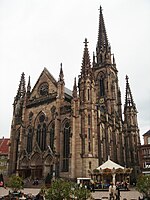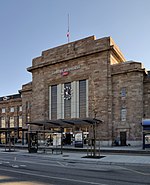Musée historique de Mulhouse

The Musée historique de Mulhouse is a municipal history museum and archaeology museum in Mulhouse, France.It is housed since 1969 in Mulhouse's Old Town Hall, a Northern Renaissance building dating mainly from 1552, which is protected as a Monument historique since 1929.The interiors of the Old Town Hall with their intact original decoration are an integral part of the museum. The museum's medieval sculptures are on display in the neighbouring Museum of Fine Arts, such as a Saint George Slaying the Dragon from 1490, originally from Tyrol. That work, as well as many others, is on permanent loan to the municipal collections of Mulhouse by the Société industrielle de Mulhouse (SIM), a learned society established in 1826 by local industrialists such as Dollfus, Koechlin, and Schlumberger which had begun collecting artworks in 1831.
Excerpt from the Wikipedia article Musée historique de Mulhouse (License: CC BY-SA 3.0, Authors, Images).Musée historique de Mulhouse
Parking Porte Jeune Souterrain Vinci, Mulhouse
Geographical coordinates (GPS) Address Nearby Places Show on map
Geographical coordinates (GPS)
| Latitude | Longitude |
|---|---|
| N 47.75 ° | E 7.34 ° |
Address
Porte Jeune
Parking Porte Jeune Souterrain Vinci
68100 Mulhouse
Grand Est, France
Open on Google Maps









